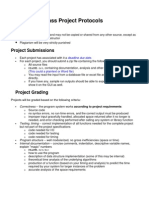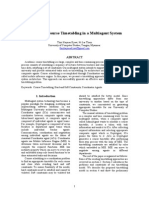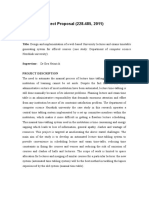0 ratings0% found this document useful (0 votes)
12 viewsIntro To Computer Programming Assignment 2
Python Questions
Uploaded by
erickbaldskieCopyright
© © All Rights Reserved
We take content rights seriously. If you suspect this is your content, claim it here.
Available Formats
Download as PDF, TXT or read online on Scribd
0 ratings0% found this document useful (0 votes)
12 viewsIntro To Computer Programming Assignment 2
Python Questions
Uploaded by
erickbaldskieCopyright
© © All Rights Reserved
We take content rights seriously. If you suspect this is your content, claim it here.
Available Formats
Download as PDF, TXT or read online on Scribd
You are on page 1/ 4
CS102/NWE102/SWE102
Assignment 2: University Timetable Automation System
Due date: 28/10/24, 08:00
Background: At a university, creating an optimized timetable for lectures, lab sessions,
and tutorials is a time-consuming and challenging task. The process involves scheduling
multiple classes across different departments, rooms, and times, while avoiding conflicts
for students, lecturers, and rooms. Your task is to create a system that automates the
timetable generation process.
Problem Description:
You need to design and implement a Python system that generates an optimal timetable
for a university’s courses, lecturers, and students. The system should ensure that no
conflicts occur, and the timetable is distributed evenly to avoid overcrowded schedules.
Requirements:
1. Class Design:
o Design classes for Course, Lecturer, Room, StudentGroup, and
TimetableSlot.
Course: Attributes should include course_code, course_name,
lecturer, student_groups, duration, preferred_time_slots, etc.
Lecturer: Attributes should include lecturer_id, name, courses,
available_timeslots, etc.
Room: Attributes should include room_id, capacity,
available_timeslots, etc.
StudentGroup: Attributes should include group_id, students,
courses, etc.
TimetableSlot: Attributes should include course, lecturer, room,
start_time, and end_time.
2. Input Data:
o The system should take the following input data:
List of courses (with their respective duration, lecturer, and student
groups).
List of lecturers (with their respective available time slots and
preferred times).
List of rooms (with room capacities and available time slots).
List of student groups (which courses they are enrolled in).
3. Constraints:
o No Conflicts: Ensure that no student group, lecturer, or room is double-
booked at the same time.
o Room Capacity: Ensure that the room assigned to a class is large enough to
accommodate all the students in the group.
o Lecturer Preferences: Where possible, assign classes to lecturers based on
their preferred time slots (e.g., a lecturer might prefer to teach between
9:00 AM and 2:00 PM).
o Minimized Gaps: The system should minimize gaps in both lecturers' and
students' timetables (i.e., avoid scheduling classes far apart unless
necessary).
o Max Workload: Ensure lecturers do not exceed a predefined maximum
workload per day (e.g., 6 hours of teaching per day).
4. Scheduling Algorithm:
o Implement an algorithm (such as backtracking, greedy, genetic algorithms,
or simulated annealing) to assign courses to time slots while satisfying all
constraints.
o The system should aim to generate an optimal timetable, considering the
constraints and preferences.
5. Output:
o The system should output a detailed timetable for each course, lecturer,
room, and student group, showing the assigned time slots.
o If conflicts are unsolvable, the system should flag them and suggest
potential manual fixes or relaxation of constraints.
6. Edge Cases:
o Handle cases where there are more courses than available time slots and
rooms.
o Ensure that small student groups are not assigned to large rooms
unnecessarily.
o Handle overlapping courses or labs that require the same student group but
must be scheduled in different slots.
Example Input:
Expected Output:
A timetable for each course, lecturer, room, and student group showing when and
where classes will be held, like this:
Extra Credit (Optional):
1. Implement a graphical user interface (GUI) that allows the university admin to
input data (courses, lecturers, rooms, etc.) and visualize the generated timetable.
2. Allow the system to support changes in the middle of the semester (e.g., a lecturer
becomes unavailable) and automatically reschedule the affected classes.
3. Implement a feature where users can export the timetable in various formats (PDF,
CSV, etc.).
You might also like
- Project Synopsis For Automatic Timetable Generator76% (21)Project Synopsis For Automatic Timetable Generator7 pages
- Smart Time-Table Generator Based On AI Report 2024-1No ratings yetSmart Time-Table Generator Based On AI Report 2024-15 pages
- Project Synopsis For Automatic Timetable GeneratorNo ratings yetProject Synopsis For Automatic Timetable Generator5 pages
- Timetable Scheduling System For Ducoe: Project ProposalNo ratings yetTimetable Scheduling System For Ducoe: Project Proposal13 pages
- Automated Course Timetabling in A Multi Agent System100% (1)Automated Course Timetabling in A Multi Agent System6 pages
- Req - Fulldoc - Avc - MSC - Cs - Automatic Schedule Allocate SystemNo ratings yetReq - Fulldoc - Avc - MSC - Cs - Automatic Schedule Allocate System64 pages
- Automated Timetable Generator: Yash Lahoti, Aaditya Punekar, Hiten Patel, Vishal BhimsariyaNo ratings yetAutomated Timetable Generator: Yash Lahoti, Aaditya Punekar, Hiten Patel, Vishal Bhimsariya4 pages
- Automated Timetable Generator: Yash Lahoti, Aaditya Punekar, Hiten Patel, Vishal BhimsariyaNo ratings yetAutomated Timetable Generator: Yash Lahoti, Aaditya Punekar, Hiten Patel, Vishal Bhimsariya4 pages
- Intelligent Emergency-Auto-Adjustment For Faculty: Name of The CandidatesNo ratings yetIntelligent Emergency-Auto-Adjustment For Faculty: Name of The Candidates17 pages
- Timetable Generation System: International Journal of Computer Science and Mobile ComputingNo ratings yetTimetable Generation System: International Journal of Computer Science and Mobile Computing5 pages
- COMSATS Institute of Information Technology Park Road, Chak Shahzad, IslamabadNo ratings yetCOMSATS Institute of Information Technology Park Road, Chak Shahzad, Islamabad10 pages
- Presidency University Bangalore: Object Oriented Analysis and Design Assignment Phase-1No ratings yetPresidency University Bangalore: Object Oriented Analysis and Design Assignment Phase-111 pages
- 01 Automated Timetabling System For University CourseNo ratings yet01 Automated Timetabling System For University Course7 pages
- Design and Implementation of A Web-Based Timetabling System-3No ratings yetDesign and Implementation of A Web-Based Timetabling System-320 pages
- Dynamic Time Table Generator: PRESENTED BY: Sandeep Sajan S Sarathchandran Sandra Sara SamNo ratings yetDynamic Time Table Generator: PRESENTED BY: Sandeep Sajan S Sarathchandran Sandra Sara Sam15 pages
- Final Year Project Proposal (228.485, 2011) : TitleNo ratings yetFinal Year Project Proposal (228.485, 2011) : Title3 pages
- Software Requirements Specification: Version 2.0 Submission Date: 17 January 2016No ratings yetSoftware Requirements Specification: Version 2.0 Submission Date: 17 January 201617 pages
- Online Scheduling System Thesis Documentation75% (4)Online Scheduling System Thesis Documentation7 pages
- Online Course Reservation System DeveloNo ratings yetOnline Course Reservation System Develo36 pages
- Dynamic Timetable Scheduler: Click To Edit Master Title StyleNo ratings yetDynamic Timetable Scheduler: Click To Edit Master Title Style9 pages
- Documentation To Be Printed Final (Main)No ratings yetDocumentation To Be Printed Final (Main)15 pages
- (Project Title) Software Requirements Specification (Student Name)No ratings yet(Project Title) Software Requirements Specification (Student Name)8 pages
- Artificial Intelligence-Semester Final Project Time Table Scheduling ProblemNo ratings yetArtificial Intelligence-Semester Final Project Time Table Scheduling Problem17 pages
- Time-Table Management System: Shailendra Singh Sanjay Kr. Yadav Sandeep Kumar Khushboo YadavNo ratings yetTime-Table Management System: Shailendra Singh Sanjay Kr. Yadav Sandeep Kumar Khushboo Yadav38 pages
- 2018 Bibliography I. Calvin's Life and TimesNo ratings yet2018 Bibliography I. Calvin's Life and Times25 pages
- Scorpio 18: A Woods Rich in Autumn ColoringNo ratings yetScorpio 18: A Woods Rich in Autumn Coloring2 pages
- Origin of The Jews and The Arabs Date of Their MosNo ratings yetOrigin of The Jews and The Arabs Date of Their Mos34 pages
- How to install SCO UnixWare 7.1.4 on the new Fujitsu PRIMERGY TX300 S5 _ RX300 S5_No ratings yetHow to install SCO UnixWare 7.1.4 on the new Fujitsu PRIMERGY TX300 S5 _ RX300 S5_3 pages
- Division of Biñan City: Self - Learning ModuleNo ratings yetDivision of Biñan City: Self - Learning Module10 pages
- Summer Training Report: Integral University, LucknowNo ratings yetSummer Training Report: Integral University, Lucknow20 pages
- Principles and Stategies in Teaching MathNo ratings yetPrinciples and Stategies in Teaching Math35 pages
- SS 3 English First Term Exam Doc 2023 - 2024 Academic SessionNo ratings yetSS 3 English First Term Exam Doc 2023 - 2024 Academic Session19 pages
- Week 7 Midterm FSIE COSaIE Ariar DesiertoNo ratings yetWeek 7 Midterm FSIE COSaIE Ariar Desierto10 pages
- Karl Debreczeny - Sino-Tibetan Artistic Synthesis in Ming DynastyNo ratings yetKarl Debreczeny - Sino-Tibetan Artistic Synthesis in Ming Dynasty35 pages
























































































